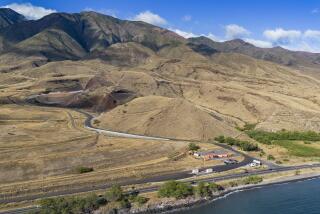Volcanic Flowâs Devastating Path Leaves a Clean Slate for New Life
HONOLULU â Pele, Hawaiian goddess of volcanoes, shows little respect for terrain and none at all for mere mortals.
For the last seven years, lava has flowed sporadically from one of Peleâs most active outlets, the east rift zone of Kilauea volcano on the Big Island of Hawaii. In the path of its most destructive flow this spring, the coastal town of Kalapana was left a disaster area.
Although no lives have been lost, more than 160 houses have been overtaken and torched by molten lava during the volcanoâs seven-year fury.
âSuch utter devastation is deceiving,â biologist William H. Amos said. âWhile Pele lays waste to existing life with one hand, she also presents a clean slate where other life can take hold, evolve, and write new chapters for biology.â
Over 10 years, Amos has seen pieces of this miraculous process on the Big Island and Maui, amid cinder fields, hidden valleys and alpine stone deserts. He has made nearly all his observations at elevations above 4,000 feet, in the rain forests and other wild habitats, since lower parts of the islands are dominated by plants and animals not native to Hawaii.
In this lofty realm Amos sought out endemic species, hardy natives whose nurseries may be bare lava, packed ash and crumbling cinder cones.
âThis steaming, trembling land, existing in its present form for only a moment in geologic time, supports endemic life forms that may predate the exotic newcomers by a million years or more,â he says. âHere grow indigenous koa and ohiâa-lehua trees, shrubby pukiawe and ohelo plants, with apapane honeycreepers and io --Hawaiian hawks--on the wing, and invertebrates such as bizarre spiders, banded tree snails and highly evolved pomace flies.â
These islands have never been directly influenced by continental land masses. Whatever life appeared in past ages arrived strictly by chance, borne on the high winds of the jet stream, on the feathers and feet of birds or in their digestive tracts. Some life perhaps rode on drifting tree trunks and mats of vegetation. Thus eggs, spores, seeds, larvae and other wanderlings made their haphazard landfalls.
On the bleak surface of a cooled lava flow on Kilauea, Amos saw life establish itself in two different forms of lava. Although the two are chemically identical, smooth, billowing pahoehoe is very fluid and streams rapidly, while rough, clinker-like aâa lava becomes thoroughly stirred and generally moves slowly, with a noisy, tumbling front.
âHere, cracks and rubble present labyrinthine opportunities for pioneering life to take hold, such as small ferns,â Amos says.
On pahoehoe flows, small pools of warm water condense from steam rising through fumaroles, heated to 2,000 degrees Fahrenheit far below the ground. Such pools foster the growth of microbial life and algae that arrive in airborne spores.
Later, when the pools evaporate, spores and cysts of the life they recently supported blow away on the trade winds, perhaps to prosper in another small aquatic world elsewhere on the shoulder of the great volcano.
One such furnace still heats rainwater that percolates down from the floor of Kilauea Iki (Little Kilauea), not far from the main volcano. The cool mountain air causes steam, the moisture that sets the stage for things to grow along fissures between lava plates.
Kilauea Ikiâs 1959 eruption littered the floor of the crater with cinders. Soon this apparent wasteland was inhabited by sword ferns, mosses, lichens and other plants. One of the first was minute moss, initially dwarfed by the peanut-size cinders around it.
Hawaii is a showplace of adaptive radiation, or the evolution of many forms from a few ancestral types.
The silversword, one of the worldâs most spectacular plants, blooms among the clouds in Mauiâs Haleakala Crater. Silverswords grow in a rotund cluster of curved, spike-like leaves in a setting as unworldly as Mars. Flat, silvery hairs protect leaf surfaces from sunlight.
The silversword, related to sunflowers, has evolved into perhaps the best example of adaptive radiation among plants. Its local relatives include two other species of silverswords, two greenswords and 25 other plants.
For Amos, no one better captured the feeling for the natural phenomena he has observed on Hawaiiâs lava fields than Sir John Arthur Thomson, a Scottish biologist. He wrote in 1920:
âLiving creatures press up against all barriers; they fill every possible niche all the world over. . . . We see life persistent and intrusive--spreading everywhere, insinuating itself, adapting itself, resisting everything, defying everything, surviving everything!â
More to Read
Sign up for Essential California
The most important California stories and recommendations in your inbox every morning.
You may occasionally receive promotional content from the Los Angeles Times.










